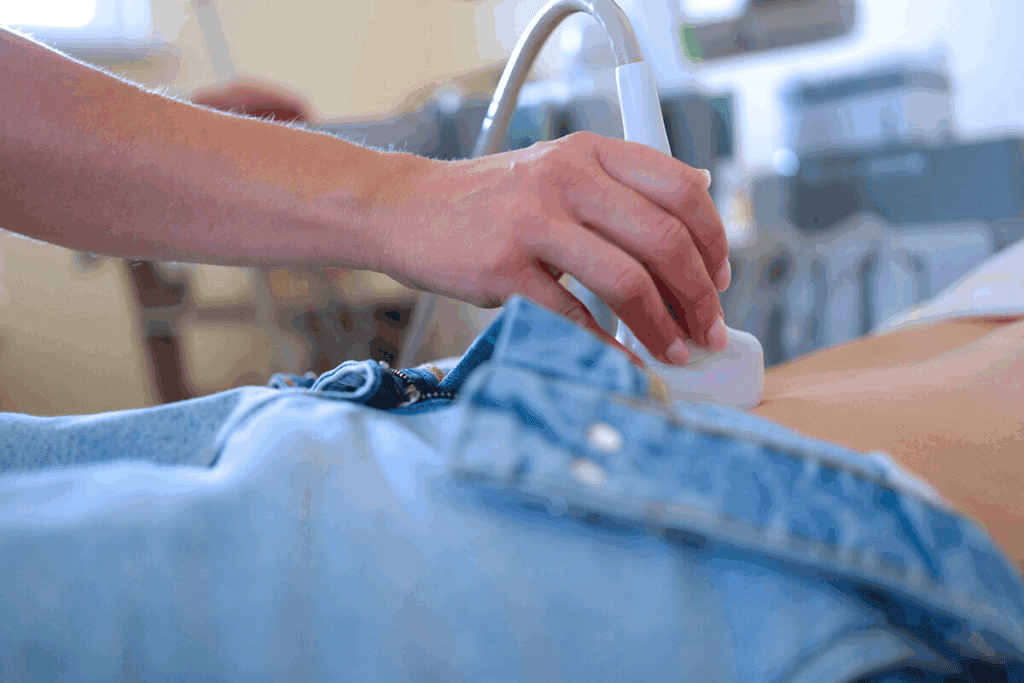Last Updated on November 25, 2025 by Ugurkan Demir

Bladder ultrasound is a key tool for doctors to see the bladder clearly. A trained healthcare pro uses a special machine to do this. It helps find issues like infections or cancer in the bladder usg bladder.
Bladder ultrasound uses sound waves to create images of the bladder. It’s a non-invasive way to check for urological issues. This method is key for diagnosing and treating many bladder problems.
To start, a clear gel is applied to the abdomen. Then, a transducer sends and receives sound waves. These waves create detailed images of the bladder.
Bladder ultrasound is safe and accurate. It helps doctors make treatment plans. It’s a great tool for managing bladder issues.

Bladder ultrasound is a key tool in urology. It’s non-invasive and very effective for checking the bladder and nearby areas. It gives real-time images, helping doctors spot many conditions correctly.
Ultrasound for bladder checks is great because it’s easy on the patient, affordable, and helps plan treatments. These perks help doctors give better care and improve patient results.
Bladder ultrasound technology uses sound waves to create detailed images of the bladder. It’s a non-invasive way to check bladder health and find any problems.
To start, a gel is applied to the abdomen. Then, a transducer sends sound waves into the body. These sound waves bounce off the bladder and come back to the transducer.
The echoes are turned into images of the bladder. This helps doctors find issues like bladder stones and tumors.
Bladder ultrasound is key in urology. It helps check urinary retention, guides procedures, and watches bladder health.
Healthcare pros use bladder ultrasound to get better at diagnosing. This leads to more effective treatments.

To get the most out of your bladder ultrasound, it’s key to prepare well. We suggest a few easy steps to make the procedure go smoothly and get good results.
Before the ultrasound, you’ll need to arrive with a full bladder. A full bladder gives a clearer view of the bladder walls and nearby areas. Drink water or other fluids as your healthcare provider tells you about an hour before.
To get ready, you should:
| Preparation Step | Description |
| Arrive with a full bladder | Drink water as directed by your healthcare provider about an hour before the procedure. |
| Wear comfortable clothing | Choose loose-fitting clothes for easy access. |
| Avoid metal items | Remove jewelry or clothing with metal parts. |
| Inform about medications | Tell your healthcare provider about any current medications. |
By following these simple steps, you can help make your bladder ultrasound go smoothly. This ensures the images taken are of high quality. We’re dedicated to giving our patients the best care and support during their diagnostic journey.
Understanding bladder ultrasound results is key to diagnosing and managing bladder issues. These results can show normal findings or abnormalities that need more study.
A normal ultrasound means the bladder is working right. This is good news, showing there are no obvious problems.
Abnormal results can point to issues like bladder stones or tumors. These might need more tests or a visit to a specialist.
After getting the results, you might need more tests or to see a specialist. It’s important to talk to your doctor about what to do next.
Getting the most out of bladder ultrasound results takes a deep understanding of the images and your health history. Working with your healthcare team is the best way to get the right diagnosis and treatment.
Bladder ultrasound technology has many benefits in medical diagnostics. It’s great because it’s non-invasive. This makes it perfect for patients who need many tests or can’t handle invasive procedures.
Accuracy and Reliability are big pluses of bladder ultrasound. It helps doctors spot issues like urinary retention and bladder problems accurately. This is key for making good treatment plans.
Another plus is its real-time imaging. This lets doctors see the bladder and its surroundings as they move. It’s super helpful during procedures that need exact guidance.
Bladder ultrasound also helps in managing patient care. It gives detailed views of the bladder. This helps track disease progress and treatment success. It’s very useful for tweaking treatment plans and boosting patient results.
To wrap it up, bladder ultrasound is a top choice in urology. Its non-invasive nature, precision, and live imaging are why it’s so valuable in medical care.
Bladder ultrasound has its limits, including technical and interpretative challenges. It’s a great tool for checking bladder health, but there are things to keep in mind. Healthcare providers need to know these to make sure they’re diagnosing correctly and caring for patients well.
One big issue is how much the person doing the ultrasound matters. The quality of the images can really change based on the technician’s skill. Also, things like the patient’s body shape and health can mess with the image quality.
There’s also a chance of misreading ultrasound pictures. Even with clear images, doctors might get it wrong if they’re not used to looking at them. This shows how important it is to have experts doing and reading the scans.
Bladder ultrasound isn’t right for every patient or situation. Some cases need more tests to get a full picture. Healthcare providers need to know when to use ultrasound with other tests.
In short, bladder ultrasound is very useful, but we must know its limits. Understanding these helps healthcare providers make better choices and care for patients better.
Bladder ultrasound is a key tool for checking bladder problems. But, it’s not the only test out there. Other options include CT scans, MRI, and cystoscopy.
Ultrasound and CT scans help find bladder issues. Ultrasound is easy and cheap, but CT scans give clearer pictures. Yet, CT scans use radiation.
MRI gives detailed images without radiation. This makes it a great choice. But, it costs more than ultrasound.
Choosing a test depends on the problem and the patient’s needs. Ultrasound is often the first choice. But, sometimes more tests are needed.
Technology is always getting better, and bladder ultrasound is no exception. Soon, we’ll see better imaging like 3D and 4D ultrasound. This will help doctors see more details, making diagnosis and treatment better.
Artificial intelligence (AI) will also be a big help. It will make diagnosing easier and more accurate. Plus, new devices will be easier to use and more portable. This means more people will have access to bladder ultrasound, leading to better health outcomes.
Bladder ultrasound is a non-invasive tool that helps check bladder health. It guides treatment and tracks disease changes. With new tech, its role will only get bigger.
A bladder ultrasound is a non-invasive way to see the bladder and find urinary tract problems.
A trained healthcare professional uses a portable ultrasound machine. The patient lies down and a gel is applied to the belly. Then, the ultrasound probe is placed on the skin.
This procedure is painless, quick, and non-invasive. It helps find issues like urinary retention, bladder stones, and some cancers.
It’s used to find urinary tract problems, check bladder function, and guide some medical procedures.
You might need to arrive with a full bladder. Avoid certain foods or drinks and follow your healthcare provider’s instructions.
A healthcare professional will apply gel to your belly. They will then use a probe to get images of your bladder.
It’s generally safe and non-invasive. But, like any medical imaging, there could be some risks or limitations.
It’s very accurate when done by a trained healthcare professional.
Yes, it can help find bladder cancer. But, more tests are needed for a final diagnosis.
No, it’s painless.
It usually takes 15-30 minutes.
Other tests like CT or MRI scans might be used. But, ultrasound is often first because it’s non-invasive and cheaper.
Yes, it’s usually safe during pregnancy. Tell your healthcare provider about your pregnancy before the test.
Talk to your primary care doctor or a specialist. They’ll decide if you need it and schedule it.
National Center for Biotechnology Information. (2025). How to Perform a Bladder Ultrasound Scan StepbyStep. Retrieved from https://pubmed.ncbi.nlm.nih.gov/20444283/
Subscribe to our e-newsletter to stay informed about the latest innovations in the world of health and exclusive offers!